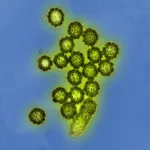(Press-News.org) A clinical trial of an experimental universal influenza vaccine developed by researchers at the National Institute of Allergy and Infectious Diseases’ (NIAID) Vaccine Research Center (VRC), part of the National Institutes of Health, has begun enrolling volunteers at Duke University in Durham, North Carolina. This Phase 1 trial will test the experimental vaccine, known as H1ssF-3928 mRNA-LNP, for safety and its ability to induce an immune response.
The trial will enroll up to 50 healthy volunteers aged 18 through 49. Three groups of study participants (10 participants each) will be vaccinated with 10, 25 and 50 micrograms of the experimental vaccine, respectively. After evaluation of the data to determine an optimum dosage, an additional 10 participants will be enrolled to receive the optimum dosage. The study also will include a group of participants who will receive a current quadrivalent seasonal influenza vaccine. This will allow the researchers a point of direct comparison between the immunogenicity and safety of the candidate vaccine and available seasonal flu vaccines. Participants will be regularly evaluated to assess the vaccine’s safety (and, secondarily, its efficacy) and will receive follow-up appointments for up to one year after vaccination.
Seasonal influenza, or flu, kills thousands of people in the United States each year. The Centers for Disease Control and Prevention estimates that between 2010 and 2020, between 12,000 and 52,000 people died of flu in the United States annually. Although annual seasonal flu vaccines are valuable tools in controlling the spread and severity of influenza, they do not provide immunity against every flu strain. Each year, before the flu season begins, scientific experts must predict which influenza strains are likely to be most common during the upcoming months and then select three or four of these strains to include in the next seasonal flu vaccine. Vaccine manufacturers then need time to produce and distribute the vaccine—during which the dominant strains of the virus can change in unexpected ways, potentially decreasing the efficacy of the vaccine. An effective universal flu vaccine could eliminate these problems by protecting its recipients against a wide variety of strains and ideally providing durable long-term immunity, so people would not need to be vaccinated every year.
“A universal influenza vaccine would be a major public health achievement and could eliminate the need for both annual development of seasonal influenza vaccines, as well as the need for patients to get a flu shot each year,” said Acting NIAID Director Hugh Auchincloss, M.D. “Moreover, some strains of influenza virus have significant pandemic potential. A universal flu vaccine could serve as an important line of defense against the spread of a future flu pandemic.”
The early-stage trial is being conducted through the Collaborative Influenza Vaccine Innovation Centers (CIVICs) program, which was created by NIAID in 2019 to support the development of broadly protective and longer-lasting flu vaccines. It is the first investigational universal flu vaccine candidate to be tested by the CIVICs program, and was manufactured at the facilities of the Duke Human Vaccine Institute (DHVI), which is a part of the CIVICS program.
A similar vaccine developed by researchers at NIAID’s VRC already has shown positive results in early clinical trials. Both vaccines use a specific portion of a flu protein, hemagglutinin (HA), to induce a broad immune response against influenza. While one portion of the HA protein, known as the head, tends to change as the flu virus spreads and evolves, a more stable portion, known as the stem, evolves very slowly and is very similar across many different types of the flu virus. By using the HA stem as the basis for a vaccine, researchers hope to induce long-term immunity against a broad range of flu viruses. Unlike the VRC’s earlier vaccine, the H1ssF-3928 mRNA-LNP vaccine candidate uses a messenger RNA (mRNA) platform. By developing and testing a variety of different platforms for a universal flu vaccine, researchers are more likely to find one that is both safe and provides strong and broad immunity against a variety of strains.
For more information about the clinical trial, visit clinicaltrials.gov using the identifier NCT05755620.
NIAID conducts and supports research—at NIH, throughout the United States, and worldwide—to study the causes of infectious and immune-mediated diseases, and to develop better means of preventing, diagnosing and treating these illnesses. News releases, fact sheets and other NIAID-related materials are available on the NIAID website.
About the National Institutes of Health (NIH): NIH, the nation's medical research agency, includes 27 Institutes and Centers and is a component of the U.S. Department of Health and Human Services. NIH is the primary federal agency conducting and supporting basic, clinical, and translational medical research, and is investigating the causes, treatments, and cures for both common and rare diseases. For more information about NIH and its programs, visit https://www.nih.gov/.
NIH...Turning Discovery Into Health®
END
TUCSON, Arizona — University of Arizona Health Sciences researchers are taking the foot off the brake in their quest to improve opioid therapy while decreasing its side effects.
Led by John Streicher, PhD, a Department of Pharmacology associate professor in the UArizona College of Medicine – Tucson and a member of the UArizona Health Sciences Comprehensive Pain and Addiction Center, the researchers have expanded upon their previous research focused on one specific protein – heat shock protein 90 – and its role in opioid receptor activation and pain relief. Their prior investigations have ...
Dr. Laura Moyer ’99 ’02G ’05 PhD, manager of metallography, light optical microscopy, and X-ray diffraction at Lehigh University, has been elected as a Fellow of ASM International, the leading association of engineers and scientists in the field of materials science.
The honor recognizes Moyer’s “outstanding leadership and technical contributions to the education of personnel in both manufacturing and academia,” benefitting the field of materials science and engineering. The ...
Researchers have developed a new smaller, lighter design for space-based imaging spectrometers with high spectral resolution. These high-dispersion imaging spectrometers could be used onboard spacecraft or satellites to study the Earth’s atmosphere or the atmospheres of other planets.
James P. McGuire, Jr. from NASA’s Jet Propulsion Laboratory in Southern California will present the new research at the Optica Design and Fabrication Conference, which will take place 04 – 08 June 2023 in Quebec City, Canada.
“This spectrometer provides the same measurement capabilities as conventional designs, but at one tenth the ...
DARIEN, IL – Four individuals have been selected as the 2023 Sleep Research Society award recipients for their outstanding contributions to the SRS, sleep and circadian science, and public health. They will be recognized Monday, June 5, during the plenary session of the SLEEP 2023 annual meeting of the Associated Professional Sleep Societies in Indianapolis.
“The SRS awards recognize the highest achievements by sleep and circadian scientists whose work supports our mission to cultivate knowledge in the field and to optimize health and well-being,” said SRS President Namni Goel. “I congratulate these leaders ...
A team of physicists has discovered a new role for a specific type of turbulence—a finding that sheds light on fluid flows ranging from the Earth’s liquid core to boiling water.
The research, which appears in the journal Proceedings of the National Academy of Sciences, centered on turbulent convection—the movement of fluid when heated from below.
“Our experiments reveal intricate movements between a free-moving body and thermal convective flows,” says Jun Zhang, a professor of mathematics and physics at New York University and NYU Shanghai, the paper’s senior author.
The study, which also included Kaizhe Wang, a researcher ...
Phosphatases of regenerating liver (PRLs) are a family of enigmatic proteins involved in cell growth and metabolism present in various species. From humans to fruit flies, they play a unique role in the growth of cancerous tumours and the spread of cancer throughout the body. New research emerging from McGill University is contributing to what is known about PRLs, which could potentially become an important tool in the development of cancer-fighting treatments.
Led by Kalle Gehring, a professor in the Department of Biochemistry and founding director of the McGill Centre for Structural Biology, the researchers focused on unravelling the mystery around PRLs. “It's ...
Athletes from less affluent countries need more education on health to prevent injuries during hard training. But, paradoxically, more knowledge can also increase the risk of injury if there is no access to medically trained expertise. This is the conclusion of researchers at Linköping University, Sweden, in a new study on inequality in athletics.
“There were astronomical differences in support resources between juniors from different parts of the world. European competitors had entire medical teams and computer-based analysis programs ...
The National Virtual Climate Laboratory (NVCL), a comprehensive web portal for climate science projects funded by the U.S. Department of Energy (DOE) Office of Science’s Biological and Environmental Research (BER) program, is now available.
The NVCL is a portal for those who have a stake in the climate crisis, such as researchers, students, faculty, and other interested organizations. Portal users will be able to find a wide range of national laboratory experts, programs, projects, activities, ...
LEBANON, NH— Advanced or metastatic estrogen receptor-positive (ER+) breast cancer is commonly treated with drugs that block the estrogen receptor. However, estrogens that stimulate the receptor can also be effective. Building on their previous studies, researchers at Dartmouth Cancer Center recently concluded a Phase II clinical trial aimed to test the efficacy of alternating between estrogen stimulation and estrogen deprivation in patients with metastatic ER+ breast cancer, and to identify tumor characteristics that predict who might benefit from this strategy. The results, newly published ahead of print in Clinical ...
Oxytocin, the so-called “love hormone,” plays a key role in the process of how a young zebra finch learns to sing by imitating its elders, suggests a new study by neuroscientists at Emory University. Scientific Reports published the findings, which add to the understanding of the neurochemistry of social learning.
“We found that the oxytocin system is involved from an early age in male zebra finches learning song,” says Natalie Pilgeram, first author of the study and an Emory PhD candidate in psychology. “It’s basic science that may lead to insights into the ...




